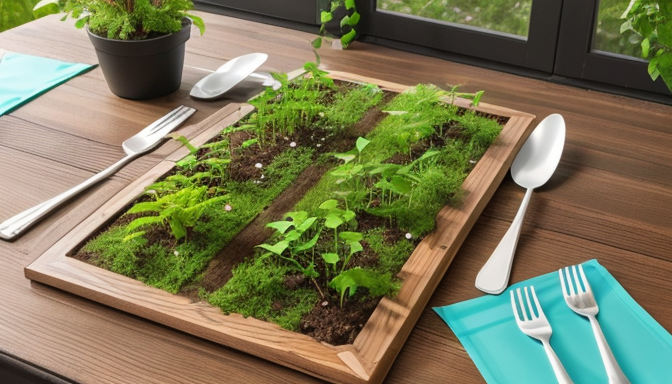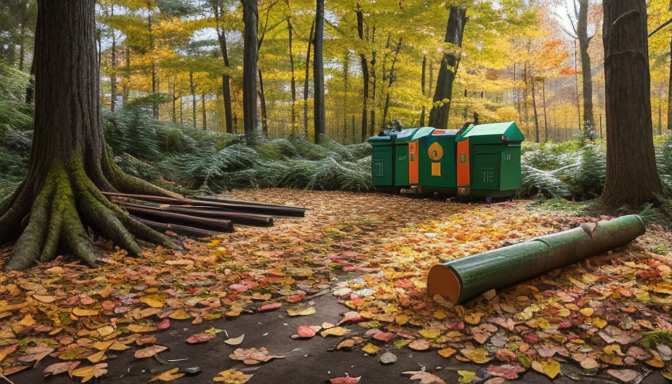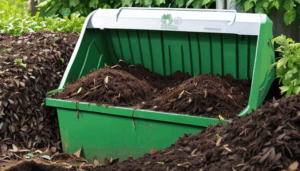In today’s world, where waste management is a growing concern, biodegradable materials are emerging as a beacon of hope. These materials, designed to break down naturally, play a crucial role in reducing the amount of waste that ends up in landfills. Imagine a world where the products we use daily can decompose and return to the earth, rather than lingering for centuries. This is not just a dream; it’s becoming a reality thanks to the advancements in biodegradable technology.
When we think about waste, it’s easy to feel overwhelmed. Every year, millions of tons of plastic waste accumulate, contributing to pollution and harming wildlife. However, biodegradable materials offer a solution by breaking down into natural substances through the action of microorganisms. This process not only minimizes landfill usage but also reduces the greenhouse gases that traditional waste emits. For instance, consider how a simple biodegradable bag can decompose in a matter of months, compared to the hundreds of years it takes for a plastic bag to break down. Isn’t that incredible?
Moreover, the benefits of using biodegradable materials extend beyond just waste reduction. They also promote sustainable practices across various industries. For example, in agriculture, biodegradable mulch films can enhance soil health while reducing plastic pollution. In packaging, businesses are turning to plant-based materials that are not only eco-friendly but also appealing to environmentally conscious consumers. This shift is not just beneficial for the planet; it’s also a smart business move.
However, the journey towards widespread adoption of biodegradable materials is not without its challenges. Consumer awareness and understanding of these products are still lacking. Many people are unaware of the differences between biodegradable and non-biodegradable materials. Additionally, the infrastructure for industrial composting is still developing, which can limit the effectiveness of these materials. Addressing these challenges is essential for maximizing the potential of biodegradable materials in waste reduction.
The Science Behind Biodegradability
Understanding the concept of biodegradability is essential in our quest to tackle the escalating waste crisis. At its core, biodegradability refers to the ability of materials to decompose through natural processes, primarily facilitated by microorganisms such as bacteria and fungi. Imagine a magical world where your trash could simply vanish into thin air, turning back into the earth, nourishing the soil instead of polluting it. This is the beauty of biodegradable materials!
But how does this process actually work? It all starts with the chemical composition of the materials. Biodegradable substances are typically made from organic compounds, which are easily broken down by microorganisms. In contrast, traditional plastics are composed of synthetic polymers that resist decomposition. For instance, while a plastic bag can take hundreds of years to break down, a biodegradable alternative can decompose in a matter of months under the right conditions.
To illustrate this, let’s consider the factors that influence biodegradability:
| Factor | Impact on Biodegradability |
|---|---|
| Temperature | Higher temperatures can accelerate microbial activity, speeding up decomposition. |
| Moisture | Water is essential for microbial growth; too little can slow down the process. |
| Oxygen | Aerobic conditions enhance the breakdown of organic matter. |
In essence, the science behind biodegradability is a fascinating interplay of chemistry and biology, where nature’s tiny workers play a crucial role in transforming waste into resources. By harnessing these natural processes, we can significantly reduce the burden on landfills and contribute to a more sustainable future. So, the next time you toss something away, think about its journey. Could it be returning to the earth instead of lingering in a landfill for centuries?

Types of Biodegradable Materials
When we talk about biodegradable materials, it’s like opening a treasure chest of possibilities for a cleaner planet! These materials are not just a fad; they represent a shift towards sustainability that we desperately need. So, what exactly falls under the umbrella of biodegradable materials? Let’s break it down!
First up, we have plant-based plastics. Unlike traditional plastics, which can linger in landfills for centuries, plant-based plastics are designed to decompose more quickly. Made from renewable resources like corn starch or sugarcane, they provide a fantastic alternative for packaging and single-use items. Imagine sipping your smoothie through a straw that won’t outlast your great-grandkids!
Next, let’s chat about compostable materials. These materials are engineered to break down in composting environments, turning into nutrient-rich soil instead of trash. Think of items like compostable plates and utensils, which are perfect for parties. You can enjoy your meal without the guilt of adding to landfill waste!
Additionally, we have natural fibers such as cotton, jute, and hemp. These materials not only decompose naturally but also offer a biodegradable option for textiles and packaging. Using natural fibers is like going back to basics, embracing the earth’s gifts while minimizing our environmental footprint.
In summary, the diversity of biodegradable materials is a beacon of hope in our fight against pollution. By choosing plant-based plastics, compostable items, and natural fibers, we can all play a part in reducing waste and nurturing our planet. Isn’t it amazing how simple choices can lead to monumental changes?
Benefits of Using Biodegradable Materials
When we think about the **environment**, the term “biodegradable materials” often pops up as a beacon of hope. But why is that? Simply put, these materials are like nature’s own cleanup crew. They break down naturally, reducing the amount of waste that ends up in our landfills. Imagine a world where your trash could simply disappear back into the earth, nourishing it instead of polluting it. Sounds pretty great, right?
One of the most significant benefits of using biodegradable materials is their ability to reduce landfill waste. Traditional plastics can take hundreds of years to decompose, while biodegradable options can break down in a matter of months. This rapid decomposition helps alleviate the pressure on our already overflowing landfills. Furthermore, by reducing landfill waste, we also cut down on the harmful greenhouse gas emissions that result from the decomposition of organic waste in anaerobic conditions.
Another advantage is that biodegradable materials promote **sustainable practices** across various industries. For instance, businesses that adopt these materials often find that they can enhance their brand image by appealing to eco-conscious consumers. This shift not only helps the planet but also boosts their bottom line. According to studies, consumers are increasingly willing to pay more for products that are environmentally friendly. It’s a win-win situation!
Moreover, biodegradable materials can contribute to a healthier ecosystem. When these materials decompose, they enrich the soil, making it more fertile and supporting plant growth. This natural cycle is crucial for maintaining biodiversity and ensuring that our planet remains vibrant and thriving.
However, the transition to biodegradable materials isn’t without its challenges. Misconceptions about their effectiveness and the lack of industrial composting facilities can hinder their widespread adoption. But with growing awareness and technological advancements, the future looks bright for biodegradable materials, paving the way for a more sustainable tomorrow.

Challenges in Biodegradable Material Adoption
While the promise of biodegradable materials is enticing, the road to widespread adoption is fraught with challenges. One of the most significant hurdles is consumer awareness. Many people still lack a clear understanding of what biodegradable means and how it differs from traditional plastics. This confusion can lead to skepticism and reluctance to embrace these eco-friendly alternatives. Imagine standing in a grocery store, staring at two similar products—one made of conventional plastic and the other biodegradable. If you’re unsure of the benefits, which one would you choose?
Another challenge lies in the industrial composting infrastructure. Biodegradable materials often require specific conditions to break down effectively, such as high temperatures and humidity levels. Unfortunately, many regions lack the necessary facilities to handle these materials, resulting in them ending up in landfills where they may not decompose as intended. This situation raises the question: how can we encourage local governments and businesses to invest in composting facilities?
Moreover, there are misconceptions surrounding biodegradable materials that contribute to their slow adoption. Some consumers believe that all biodegradable products will decompose in any environment, which is far from the truth. This misunderstanding can lead to irresponsible disposal practices, undermining the very benefits these materials aim to provide. For instance, if someone tosses a biodegradable item into a regular trash bin, it may not break down properly, thus defeating its purpose.
Lastly, the cost factor cannot be ignored. Biodegradable materials often come with a higher price tag compared to their conventional counterparts. This can deter both consumers and businesses from making the switch. In a world where every penny counts, how do we convince people that investing in sustainability is worth it?
The Future of Biodegradable Materials
The future of biodegradable materials is not just a trend; it’s a revolution waiting to unfold. As we continue to grapple with the overwhelming amounts of waste generated daily, these materials present a beacon of hope. Imagine a world where your plastic bag could decompose in your backyard instead of lingering in a landfill for centuries! Sounds like science fiction, right? But it’s becoming a reality.
Innovations in biodegradable technology are emerging rapidly. Researchers are developing new materials that break down even faster and more efficiently than current options. For instance, advancements in plant-based plastics are paving the way for alternatives that not only mimic the properties of conventional plastics but also offer a sustainable lifecycle. Moreover, the integration of biodegradable materials into various industries, from packaging to textiles, is gaining momentum.
However, the journey toward widespread adoption is not without its hurdles. One of the primary challenges is the need for robust industrial composting infrastructure. Without adequate facilities, even the best biodegradable materials may not reach their full potential. Furthermore, consumer awareness plays a crucial role. Many people still harbor misconceptions about what biodegradable truly means, often confusing it with recyclable or compostable. This lack of understanding can hinder the transition to these eco-friendly options.
Looking ahead, we can expect to see a surge in policy changes that promote the use of biodegradable materials. Governments around the world are beginning to recognize the importance of sustainability, which could lead to incentives for businesses to adopt greener practices. Additionally, consumer demand for environmentally friendly products is likely to push companies to innovate and invest in biodegradable solutions.
In conclusion, while challenges remain, the future of biodegradable materials is bright. With continued innovation, increased awareness, and supportive policies, we are on the brink of a significant shift towards a more sustainable and waste-free world.
Frequently Asked Questions
- What are biodegradable materials?
Biodegradable materials are substances that can decompose naturally through the action of living organisms, typically microbes. Unlike traditional plastics, they break down into natural elements, reducing waste and pollution.
- How do biodegradable materials help reduce waste?
These materials significantly cut down landfill waste by decomposing faster than conventional materials. This process not only minimizes the volume of waste but also lowers greenhouse gas emissions that typically arise from decaying organic matter.
- Are all biodegradable materials compostable?
No, not all biodegradable materials are compostable. Compostable materials break down under specific conditions into nutrient-rich compost, while some biodegradable materials may require different environments to decompose fully.
- What challenges do biodegradable materials face?
Challenges include limited consumer awareness, insufficient industrial composting facilities, and misconceptions about their effectiveness. These hurdles can slow down their adoption and integration into everyday life.
- What is the future of biodegradable materials?
The future looks promising with ongoing innovations and advancements in technology. As policies evolve and awareness increases, biodegradable materials are expected to play a pivotal role in creating a sustainable environment.

